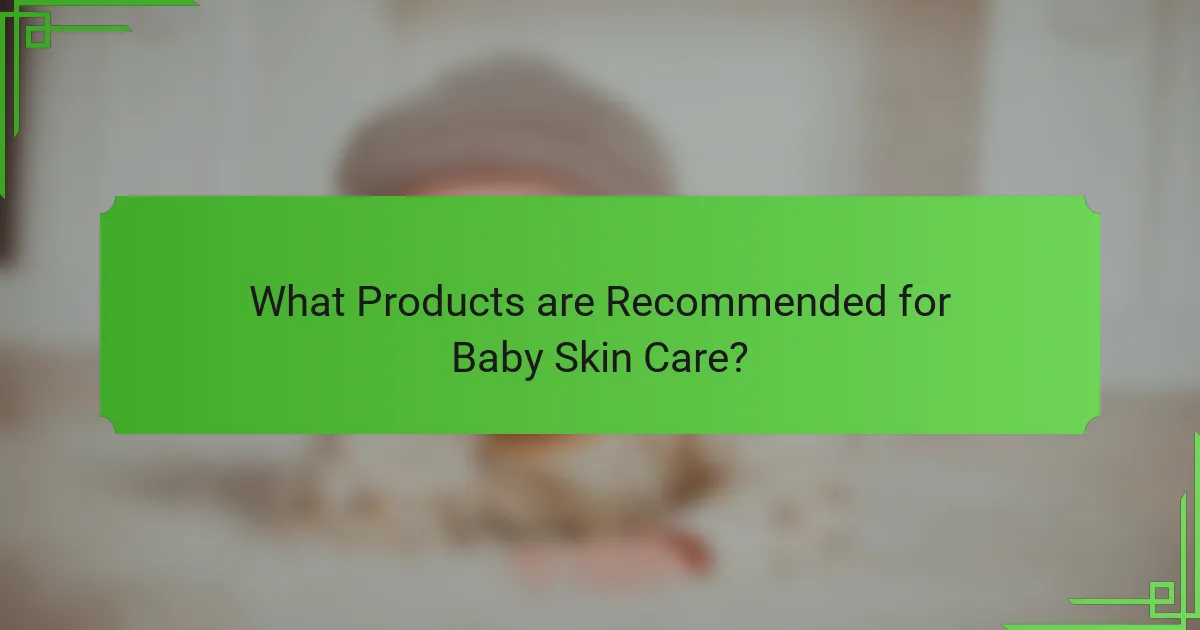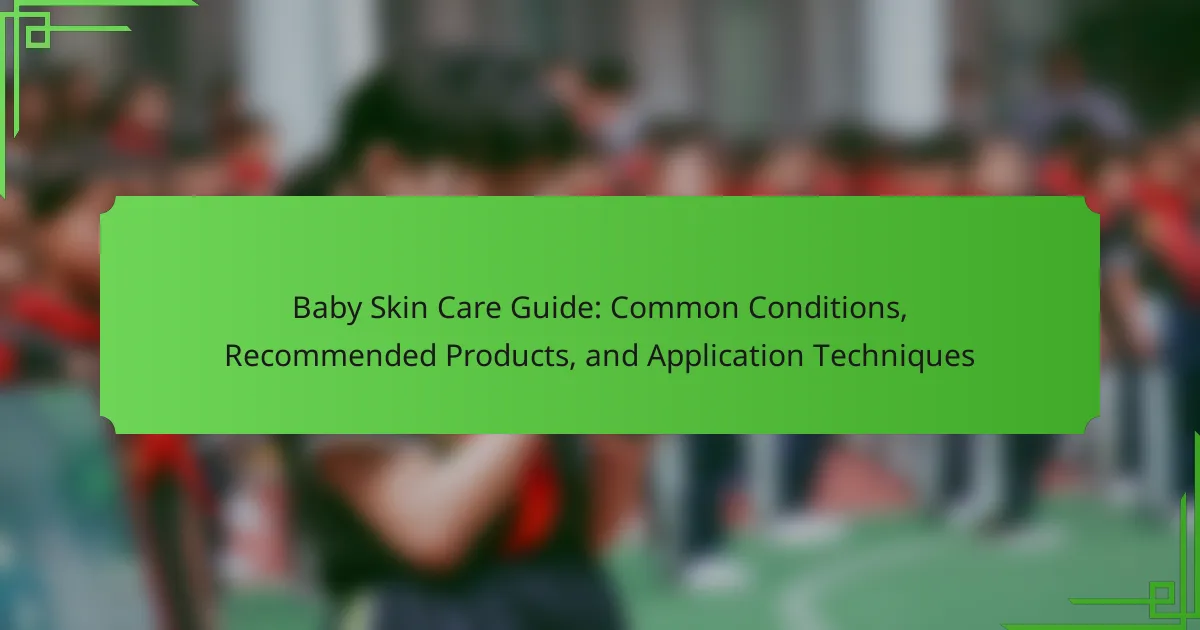Baby skin care encompasses the practices and products aimed at maintaining the health and hygiene of an infant’s delicate skin. This guide covers common skin conditions such as diaper rash and eczema, along with recommended products that include gentle cleansers, moisturizers, and diaper creams specifically formulated for sensitive skin. Key application techniques emphasize gentle cleansing, proper moisturizing, and careful product application to prevent irritation. Pediatric dermatologists advocate for the use of natural ingredients and fragrance-free formulations to ensure safety and effectiveness. Additionally, the importance of performing patch tests when introducing new products is highlighted to avoid allergic reactions.

What is Baby Skin Care?
Baby skin care refers to the practices and products used to maintain the health and hygiene of an infant’s skin. It involves gentle cleansing, moisturizing, and protecting the skin from irritants. Baby skin is delicate and more susceptible to dryness and irritation compared to [censured] skin. Therefore, specialized products are formulated to be safe and effective for infants. Common practices include using mild, fragrance-free cleansers and applying moisturizers to keep the skin hydrated. Pediatric dermatologists recommend regular skin care routines to prevent conditions like diaper rash and eczema. Proper baby skin care contributes to overall skin health and comfort for infants.
Why is Baby Skin Care Important?
Baby skin care is important because it protects the delicate skin of infants. Infants have thinner skin compared to adults, making them more susceptible to irritation and infection. Proper skin care helps maintain the skin’s natural barrier function. This reduces the risk of conditions like eczema and diaper rash. Research indicates that effective skin care can prevent long-term skin issues. For example, a study published in the Journal of Pediatric Dermatology found that early skin care interventions significantly decrease the incidence of dermatitis. Therefore, consistent baby skin care is essential for overall health and comfort.
What are the unique characteristics of baby skin?
Baby skin is notably different from [censured] skin in several unique ways. It is thinner, making it more sensitive and susceptible to irritation. The outer layer, known as the stratum corneum, is less developed, providing less protection. Baby skin has a higher moisture content, which can lead to increased vulnerability to dryness. Additionally, it contains fewer melanocytes, resulting in less natural protection against UV rays. The skin also has a unique pH level, which is more alkaline compared to [censured] skin. These characteristics necessitate gentle care products specifically formulated for infants.
How does baby skin differ from [censured] skin?
Baby skin differs from [censured] skin in several key ways. Baby skin is thinner and more delicate than [censured] skin. It has a higher water content, making it more prone to moisture loss. The skin barrier in babies is not fully developed, leading to increased sensitivity. Additionally, baby skin has fewer melanocytes, resulting in less pigmentation and a higher risk of sunburn. [censured] skin contains more oil glands, which help maintain moisture levels. The structural differences also include a different composition of collagen and elastin, affecting elasticity and firmness. These characteristics make baby skin require specific care to protect its fragile nature.
What Common Skin Conditions Affect Babies?
Common skin conditions that affect babies include diaper rash, eczema, and baby acne. Diaper rash occurs due to prolonged exposure to moisture and irritants in the diaper area. Eczema, or atopic dermatitis, presents as red, itchy patches and can be triggered by allergens. Baby acne appears as small red or white bumps on the face, often resolving on its own. Other conditions include cradle cap, characterized by scaly patches on the scalp, and impetigo, a contagious bacterial infection. Understanding these conditions helps in providing appropriate care and treatment.
What is diaper rash and how can it be treated?
Diaper rash is a skin irritation that occurs in the diaper area of infants. It is characterized by red, inflamed skin that can be painful or uncomfortable for the baby. Diaper rash often results from prolonged exposure to moisture, friction, or irritants in urine and feces. Treatment typically involves keeping the area clean and dry. Frequent diaper changes can help reduce moisture. Applying a barrier cream can protect the skin from further irritation. In some cases, using a mild hydrocortisone cream may be recommended for inflammation. If the rash persists or worsens, consulting a pediatrician is advisable.
How do eczema and baby acne manifest in infants?
Eczema in infants typically manifests as red, itchy patches on the skin. These patches may appear on the face, scalp, and behind the knees. The skin can become dry, cracked, and may ooze fluid in severe cases. Baby acne, on the other hand, usually presents as small, red bumps or pimples on the cheeks, forehead, and chin. This condition is often not itchy and usually resolves on its own within a few weeks. Both conditions are common in infants and can be mistaken for each other due to their similar appearance. Understanding these differences helps in proper identification and care.

What Products are Recommended for Baby Skin Care?
Gentle cleansers, moisturizers, and diaper creams are recommended for baby skin care. Products should be free from harsh chemicals and fragrances. Look for cleansers that contain natural ingredients like chamomile or aloe vera. Moisturizers should ideally include ingredients like shea butter or glycerin for hydration. Diaper creams should contain zinc oxide to protect against rashes. Pediatricians often suggest brands like Aquaphor, Cetaphil Baby, and Burt’s Bees. These products are formulated specifically for sensitive baby skin. They help prevent dryness and irritation effectively.
What types of products should be used for baby skin care?
Moisturizers, cleansers, and barrier creams are essential for baby skin care. Moisturizers help maintain hydration and prevent dryness. Look for products with natural ingredients like shea butter or coconut oil. Cleansers should be gentle and free from harsh chemicals. Mild, fragrance-free formulas are ideal for sensitive skin. Barrier creams protect against rashes and irritation. Zinc oxide-based creams are effective for diaper rash. Always choose products specifically formulated for babies to ensure safety and efficacy.
Which ingredients are safe and effective for baby skin?
Ingredients that are safe and effective for baby skin include aloe vera, chamomile, and calendula. Aloe vera is known for its soothing properties and can help relieve irritation. Chamomile has anti-inflammatory effects, making it beneficial for calming sensitive skin. Calendula is often used for its healing properties and can aid in the treatment of diaper rash. These ingredients are generally well-tolerated and are found in many baby skincare products. Studies have shown that these natural ingredients can provide relief without causing adverse reactions in infants.
How do you choose between lotions, creams, and oils?
Choose lotions for lightweight hydration, creams for thicker moisture, and oils for deep nourishment. Lotions are typically water-based and absorb quickly. They are ideal for light hydration and daily use. Creams contain more oil, providing a richer texture. They are suitable for dry skin and areas needing extra moisture. Oils are concentrated and penetrate deeply into the skin. They are beneficial for very dry skin and can lock in moisture effectively. Each option serves different skin needs based on hydration levels and skin conditions.
Are there specific brands that are trusted for baby skin care?
Trusted brands for baby skin care include Johnson’s Baby, Aveeno Baby, and Cetaphil Baby. Johnson’s Baby has a long history of gentle formulas designed for sensitive skin. Aveeno Baby uses natural ingredients like oatmeal, which is known for its soothing properties. Cetaphil Baby offers products that are hypoallergenic and free from harsh chemicals. These brands are widely recommended by pediatricians and dermatologists for their safety and effectiveness. Consumer reviews and clinical studies often highlight their reliability in caring for delicate baby skin.
What are some top-rated baby skin care brands?
Top-rated baby skin care brands include Cetaphil, Aveeno, and Johnson’s Baby. Cetaphil is known for its gentle formulations suitable for sensitive skin. Aveeno uses natural ingredients like oatmeal to soothe and moisturize. Johnson’s Baby has a long-standing reputation for safety and effectiveness. Other notable brands are Babyganics and Burt’s Bees, which focus on organic and non-toxic ingredients. These brands are often recommended by dermatologists and pediatricians for their quality and safety standards.
How do you evaluate the safety of baby skin care products?
To evaluate the safety of baby skin care products, analyze the ingredient list for harmful substances. Look for common allergens and irritants, such as fragrances and parabens. Check for certifications from reputable organizations, indicating the product meets safety standards. Research the brand’s reputation and history concerning product recalls or safety issues. Review clinical studies or dermatological tests that support the product’s safety claims. Consult pediatricians or dermatologists for recommendations on safe products. Use resources like the Environmental Working Group’s Skin Deep database for additional safety ratings. These steps ensure informed decisions regarding baby skin care safety.

What are the Best Application Techniques for Baby Skin Care?
The best application techniques for baby skin care include gentle cleansing, proper moisturizing, and careful application of products. Gentle cleansing involves using a soft washcloth or cotton ball with lukewarm water. This reduces irritation and ensures the skin remains hydrated.
Proper moisturizing should follow immediately after bathing. Applying a fragrance-free moisturizer helps to lock in moisture. It is recommended to use products specifically formulated for babies. These products often contain fewer irritants.
Careful application of creams or ointments is essential. Use your fingertips to apply a thin layer in a gentle, circular motion. This promotes absorption and minimizes discomfort.
Always perform a patch test when introducing new products. This helps to identify any potential allergic reactions. Pediatric dermatologists often recommend this practice for sensitive baby skin.
How should baby skin care products be applied?
Baby skin care products should be applied gently and in small amounts. Begin by ensuring the baby’s skin is clean and dry. Use your fingertips to apply the product, avoiding excessive pressure. Spread the product evenly across the skin, focusing on areas prone to dryness or irritation. For lotions or creams, a light, circular motion can help with absorption. Always test a small amount on a patch of skin first to check for any adverse reactions. This method minimizes the risk of irritation and ensures effective application.
What are the steps for applying lotion or cream to a baby?
To apply lotion or cream to a baby, follow these steps. First, gather all necessary items, including the lotion or cream and a clean cloth. Ensure the baby is in a comfortable position, such as lying on a soft surface. Next, take a small amount of lotion or cream in your hands. Rub your hands together to warm the product slightly. Gently apply the lotion or cream to the baby’s skin, starting with areas prone to dryness, like elbows and knees. Use soft, circular motions to massage the product into the skin. Avoid applying lotion to the baby’s face unless specifically designed for that purpose. After applying, wash your hands thoroughly. Always check for any signs of irritation or allergic reaction after application.
How can you create a soothing bath routine for your baby?
To create a soothing bath routine for your baby, start by ensuring the water temperature is warm but not hot, ideally around 98.6°F (37°C). Use a gentle, fragrance-free baby soap to avoid skin irritation. Limit bath time to 10-15 minutes to prevent drying out the skin. Support your baby securely during the bath to enhance comfort and safety. After bathing, gently pat the baby dry with a soft towel, avoiding rubbing. Apply a mild, hypoallergenic moisturizer to lock in moisture and protect the skin. Bathing before bedtime can help signal to your baby that it is time to sleep, promoting relaxation.
What tips can help prevent common skin issues in babies?
To prevent common skin issues in babies, maintain proper hygiene and moisture. Regularly bathe the baby with gentle, fragrance-free soap. Use lukewarm water to avoid skin irritation. After bathing, apply a hypoallergenic moisturizer to retain skin hydration. Dress the baby in loose, breathable fabrics to prevent irritation. Change diapers frequently to avoid diaper rash. Ensure the baby’s environment is free from harsh chemicals and allergens. Keep the baby’s nails trimmed to prevent scratching. Regular pediatric check-ups can help identify and address skin concerns early.
How often should you moisturize a baby’s skin?
Moisturizing a baby’s skin should be done at least once daily. This helps maintain skin hydration and prevents dryness. Babies have delicate skin that can easily become dry or irritated. Applying moisturizer after bathing is particularly effective. It locks in moisture and helps protect the skin barrier. Pediatric dermatologists recommend using a gentle, fragrance-free moisturizer. Regular moisturizing can reduce the risk of common skin conditions, such as eczema. Keeping the skin well-hydrated supports overall skin health in infants.
What are the best practices for maintaining healthy baby skin?
To maintain healthy baby skin, practice gentle cleansing, moisturizing, and sun protection. Use a mild, fragrance-free cleanser during bath time to avoid skin irritation. Limit bath time to 5-10 minutes to prevent dryness. After bathing, apply a hypoallergenic moisturizer to lock in moisture. Dress the baby in breathable fabrics to allow skin to breathe. Always use sunscreen with at least SPF 30 when outdoors. Regularly check for signs of irritation or rashes, and consult a pediatrician if concerns arise. These practices help ensure the skin remains hydrated and protected from environmental factors.
Baby skin care is the practice of maintaining the health and hygiene of an infant’s delicate skin through gentle cleansing, moisturizing, and protection from irritants. This article covers the importance of baby skin care, highlighting the unique characteristics of baby skin and common conditions such as diaper rash and eczema. Recommended products and application techniques are discussed, focusing on safe ingredients and effective methods for maintaining healthy skin. Additionally, best practices for preventing skin issues and promoting overall skin health in infants are outlined.
